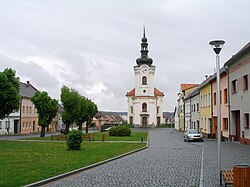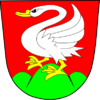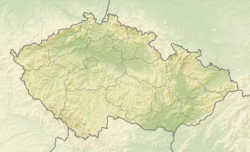Černošín (German: Tschernoschin) is a town in Tachov District in the Plzeň Region of the Czech Republic. It has about 1,200 inhabitants.
Černošín | |
|---|---|
 Town square with the Church of Saint George | |
| Coordinates: 49°49′8″N 12°52′56″E / 49.81889°N 12.88222°E | |
| Country | |
| Region | Plzeň |
| District | Tachov |
| First mentioned | 1155 |
| Government | |
| • Mayor | Vladimír Krejča |
| Area | |
| • Total | 42.21 km2 (16.30 sq mi) |
| Elevation | 500 m (1,600 ft) |
| Population (2024-01-01)[1] | |
| • Total | 1,199 |
| • Density | 28/km2 (74/sq mi) |
| Time zone | UTC+1 (CET) |
| • Summer (DST) | UTC+2 (CEST) |
| Postal codes | 349 01, 349 58 |
| Website | www |
Administrative parts
editThe villages of Krásné Údolí, Lažany, Lhota, Ostrovce, Pytlov, Třebel, Víchov and Záhoří are administrative parts of Černošín.
Etymology
editThe name of the town is probably derived from the personal name Černoš, who was a local lord.[2]
Geography
editČernošín is located about 18 kilometres (11 mi) east of Tachov and 36 km (22 mi) west of Plzeň. It lies in the Plasy Uplands. The highest point is the hill Vlčí hora at 704 m (2,310 ft) above sea level. The Mže River flows along the southern municipal border. Its tributary, the stream of Kosí potok, forms the western municipal border before it joins the Mže.
History
editThe first written mention of Černošín is from 1155, but this document has not been preserved. The next mention of Černošín is from 1290. From the 14th to the 17th century, it was owned by the Schwamberg family. In 1541, Černošín was promoted to a town. After the town obtained various rights and privileges in 1551, it became an important trade and craft centre. The development was stopped by the Thirty Years' War, during which the town was heavily damaged and depopulated. In the middle of the 17th century, the town received new privileges and was resettled by German immigrants.[2]
Demographics
edit
|
|
| ||||||||||||||||||||||||||||||||||||||||||||||||||||||
| Source: Censuses[3][4] | ||||||||||||||||||||||||||||||||||||||||||||||||||||||||
Transport
editThe Plzeň–Karlovy Vary railway briefly crosses the municipal territory in the south, but there is no train station.
Sights
editThe main landmark of Černošín is the Church of Saint James the Great. It was built in the Baroque style in 1711–1736, on the site of an old Gothic church from the 14th century.[5]
A tourist destination is the ruin of the Volfštejn Castle, located in the woods at the foot of Vlčí hora. It was built in the middle of the 13th century, the first written mention dates from 1316. It was destroyed during the battles of King George of Poděbrady with the opposition in 1470. The best-preserved part is the bergfried with a Romanesque arched portal. Today the ruin is freely accessible.[6]
Twin towns – sister cities
edit- Pullenreuth, Germany
References
edit- ^ "Population of Municipalities – 1 January 2024". Czech Statistical Office. 2024-05-17.
- ^ a b "Historie města" (in Czech). Město Černošín. Retrieved 2023-11-01.
- ^ "Historický lexikon obcí České republiky 1869–2011" (in Czech). Czech Statistical Office. 2015-12-21.
- ^ "Population Census 2021: Population by sex". Public Database. Czech Statistical Office. 2021-03-27.
- ^ "Kostel sv. Jiří" (in Czech). National Heritage Institute. Retrieved 2023-11-01.
- ^ "Zřícenina hradu Volfštejn" (in Czech). National Heritage Institute. Retrieved 2023-11-01.
- ^ "Partnerská obec" (in Czech). Město Černošín. Retrieved 2022-09-20.


